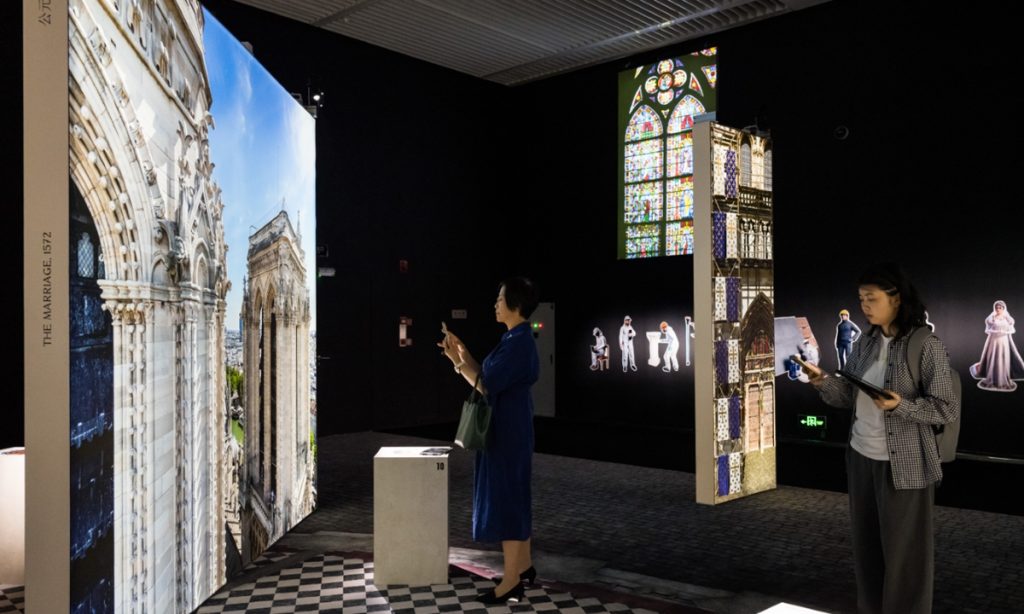Notre Dame exhibit comes to Beijing

In one of the northern exhibition halls of the National Museum of China, a sculpture of a gargoyle, which was originally designed as a foremost part of the rainwater drainage system of Paris' famed Notre Dame cathedral, sits silently among orderly arranged devices, ready to accompany visitors on a journey between the past and the present, the virtual and the real.
With Notre Dame cathedral about to complete its restoration and reopen to the public in December after a massive fire, an immersive augmented reality (AR) exhibition depicting the cathedral's history of construction, destruction and reconstruction will kick off at the National Museum of China on Thursday.
The exhibition, jointly held by the museum and the Public Establishment in Charge of the Conservation and Restoration of Notre Dame de Paris and sponsored by the L'oreal Group, is also part of celebrations of the 60th anniversary of the establishment of China-France diplomatic ties and the China-France Year of Culture and Tourism.
Although this is a touring exhibition, the unique part of the stop at the National Museum of China is four original sculptures embellishing the cathedral and reflecting the mid-19th century taste for symbols and a fantasy Middle Ages, including a gargoyle, a chimera and a plant-covered human figure. The Chinese curatorial team of the National Museum put forward the idea of adding real cultural relics to the AR exhibition to enhance immersion and successfully reached an agreement with the French side.
"We would like to relate the history of the Notre Dame de Paris, a shared cultural legacy of the whole world with a novel digital method that has been approved and appreciated by younger generations," Zhu Xiaoyun, director of the Department of International Cooperation of the National Museum of China and the Chinese curator of the exhibition, told the Global Times on Wednesday.
Zhu noted that the exhibition, a result of China-France cultural cooperation, interprets the meaning of exchanges and mutual learning among civilizations very well.
"Mutual learning refers to learning from each other's advantages. What the exhibition showcases regarding how a cultural legacy with a history of more than 800 years has been revived from fatal destruction provide us new insight into the museum's duty to conserve immovable cultural legacies," Zhu noted.
Stepping into the exhibition hall, visitors can use a provided tablet computer to travel across the ocean and through time to see the world of Notre Dame. There are over 20 cylinder-shaped tables set in the hall with a QR code pasted on each one. When scanning these codes with a tablet, a portion of a painting depicting the cathedral at different eras unfolds so that visitors can see the many details of its history, such as how its Gothic ceiling was built.
Building a private conversation with the cathedral throughout the exhibition, visitors can explore the secrets of its Gothic architecture, including its religious background and historical changes, in the virtual world by clicking the buttons on the screen. According to the curator, the information about the cathedral is so vast that it would take at least four hours to finish scrolling through the entire content on the tablet.
Four original fragments of the building are arranged among these devices, allowing visitors to shuttle between the virtual and real worlds and get closer to the essence of French culture.
"This was just a digital exhibition at the beginning in which we used new technology to introduce something that the public doesn't know very well. Now we also have real artifacts. This is important because we are using all these elements to recreate reality and to provide more information," Gergely László, director of operations and quality of French tech company Histovery and also the French curator of the exhibition, told the Global Times on Wednesday.
Zhu said that cultural institutions in China and France have jointly launched a series of events to celebrate 2024's special anniversary and promote people-to-people exchanges. This year, the cultural symbol that is Notre Dame will be a messenger for this celebration.
The exhibition will travel to Hong Kong after the Beijing leg.